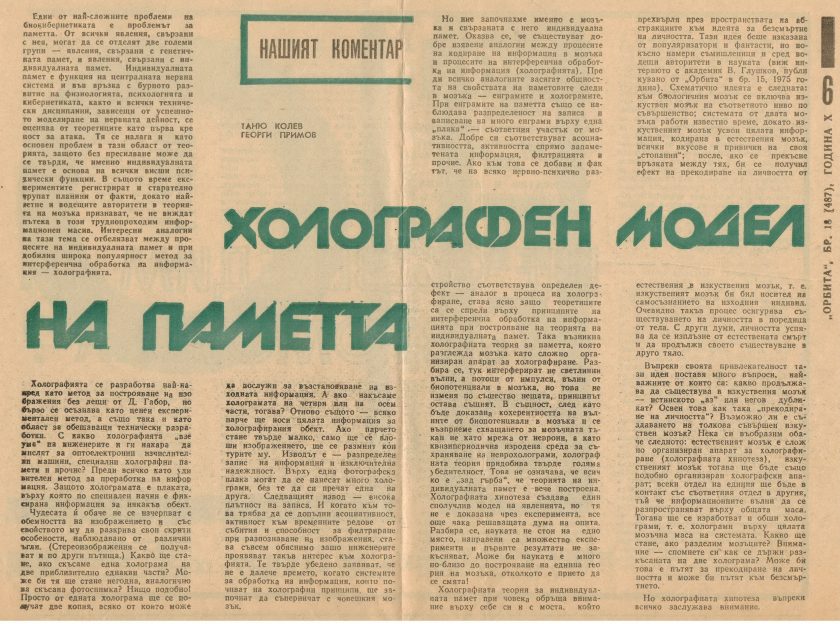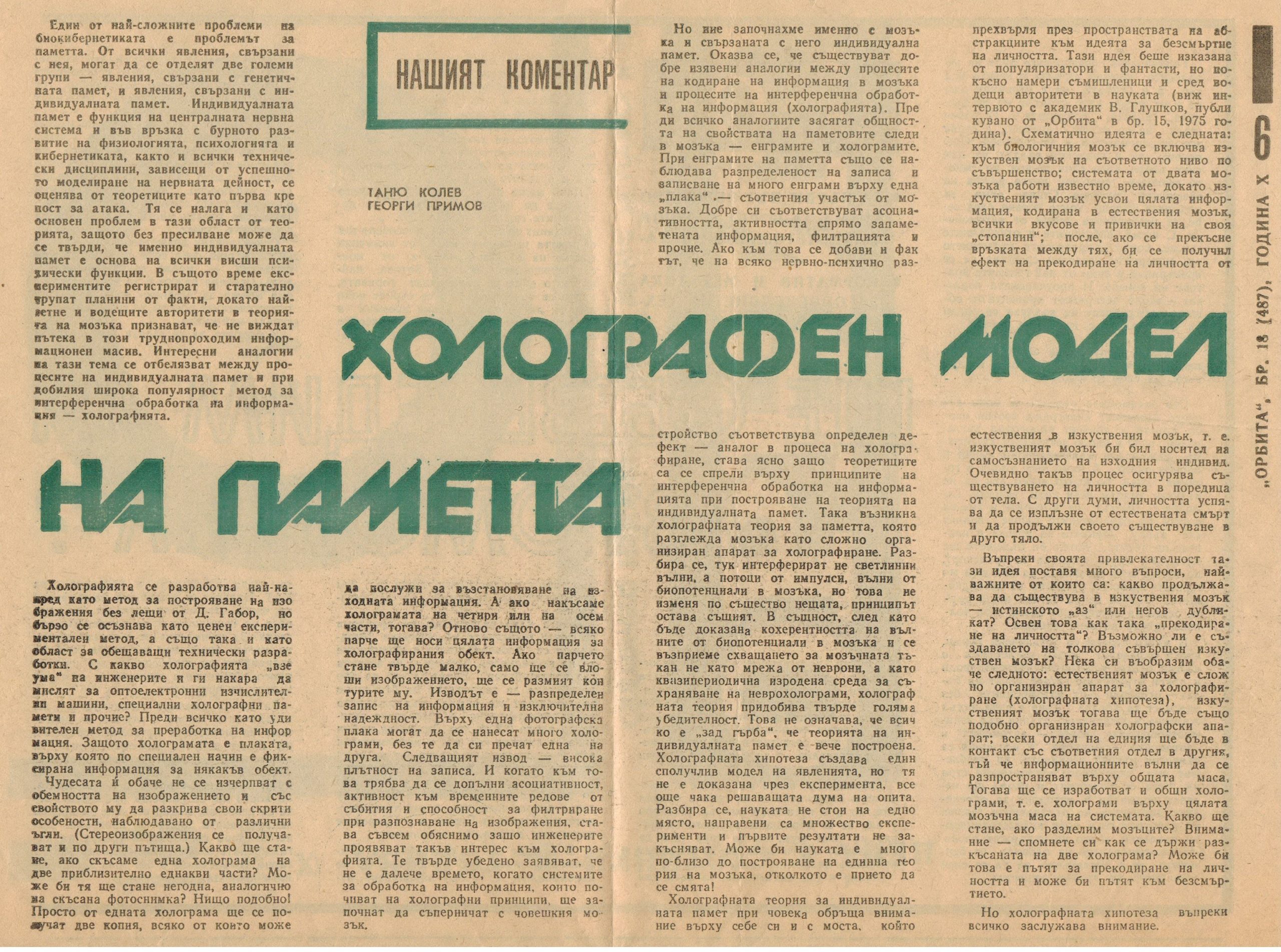HOLOGRAPHIC MODEL OF MEMORY
Published in Orbita newspaper on May 06, 1978
Tanuy Kolev
Georgi Primov
The memory problem is one of the most complex problems of bio-cybernetics. Of all the phenomena, associated with it, two large groups can be separated: phenomena related to the genetic memory, and phenomena related to the individual memory. The individual memory is a function of the central nervous system. It has been evaluated by the theorists to be the first fortress attacked by the rapid development of physiology, psychology and cybernetics, as well as all technical disciplines that depend on successful modeling of the nervous activity. The individual memory is the basis of all higher psychological functions, thus it becomes a major problem in this theoretical area. At the same time the recorded experiments have piled mountains of facts so far and the leading scientific authorities in the brain theory recognize that they see no trail in this difficult data warehouse. Interesting analogies on this subject are noted between the processes of individual memory and the widely popular method of interferential processing of information – the holography.

The holography has been initially developed as a method of building images without lenses by D. Gabor, but it has been quickly acknowledged as a valuable experimental method, as well as an area of promising technical developments. But how it happened, that the holography “catch the breath” of the engineers and made them to think about optoelectronic computing machines, special holographic memories, and so on? Above all, it is an amazing way for information processing. The hologram is the plaque, on which information about an object is fixed in a very special way.
Its miracles, however, are not exhausted with the three dimensional look of the image and its feature to reveal hidden features, seen from different angles. (Stereo images could be obtained also via different methods.)
What would happen if we divide a hologram in two approximately equal parts?
Would it become damaged, similar to a torn photo shot? By contrast to the conventional photography, cutting the hologram in two pieces will turn the hologram into two copies, each of which can serve to restore the initial input information. If we further cut the hologram into four or eight parts, again we see the same result – each piece carries all the information about the holographic object. If the piece becomes too small, it would eventually lead to loss of overall picture quality. The picture will worsen; its outline will blur but the information about the whole object will remain in each of the pieces. The first conclusion about hologram is that it represents a distributed record of information and it is a one with exceptional reliability.
Many holograms can be applied to a photographic plaque without observing interference between the different images one with another. Thus next conclusion – hologram has a high density of the record. And, if we complement the two features above with associativity, i.e. activity to the temporary series of events and ability to filter, or recognize particular images, it becomes quite understandable why engineers are showing up such an interest in holography. They very convincingly say that it is not far the time when information processing systems based on holographic principles will begin to compete with the human brain.
But we started exactly with the brain and its associative memory.
It turns out, that there are well-established analogies between the encoding information processes in the brain and processes of interference processing of information (the holography). Above all, the analogies are observed between the memory trail properties in the brain – the engrams from one hand and the holograms from the other. The brain memory engrams also demonstrate distributed recording and ability to record many engrams on one “plaque” – the corresponding region of the brain. There is an analogue between the brain memory engrams and the holograms in terms of associativity, the activity towards the stored information, filtration, etc. In addition, in every neuro-mental disorder one can find specific defects which can be taken as an analogue in the process of holography. All of the above leads to a well-founded attempt to build a theory of the individual memory by the use the principles of interference information processing.
This is how the holographic theory of the memory examining the brain as a complexly organized apparatus for holography has emerged.. Of course, there are no light waves interfering here, but streams of impulses, waves of bio-potentials in the brain, but that does not change things in essence, the principle remains the same.
The holographic theory would be much more convincing if we are able to demonstrate that the waves of biopotentials in the brain are coherent, and if the brain tissue is not perceived as network of neurons, but as a quasi-periodic distorted medium for storing neuro-holograms. It does not mean that that the theory of individual memory is already built. The holographic hypothesis creates a successful model of the phenomena, but it is not yet proven by the experiment, it is still waiting for the decisive word of essays. Of course, science does not stand in one place, multiple experiments are on its way and the first results would not be delayed. Maybe, the science is closer to the building of a unified brain theory that one could imagine.
Let’s make one step further!
The holographic theory of the human memory creates a bridge for the idea of personal immortality that brings it from the space of abstractions to the table of the practical science. Initially, this idea was put forth by promoters and sci-fi authors, but later it found supporters among some of the leading names in science (see the interview with Academician V. Glushkov published by “Orbita” in issue 15, 1975).
In essence the idea is as follows:
The biological brain is connected to an artificial brain with matching level of sophistication and capacity. The system of two brains (human & artificial) works in this way for certain period of time until the artificial one masters all the information coded in the human brain. All the tastes and habits of the “owner” are adopted. Then, if the relationship between them is broken this would have an effect of transcoding the person from the natural brain into the artificial one. The artificial brain would be a carrier the self-consciousness of the individual. Obviously, such a process could ensure the existence of the personality in a series of bodies (artificial brains).
In other words, the person is able to escape from the natural death to continue its existence in another body.
Despite its attractiveness, this idea raises many questions:
What is this that exists in the artificial brain – is it a true “I” or a duplicate of it?
Furthermore, what is meant by “transcoding” the person”?
Is it possible to create an artificial brain with such level of sophistication and complexity?
Let think for a second: the natural brain is a complex apparatus for making holograms (holographic hypothesis), so the artificial brain will then be similarly organized holographic apparatus; each region of the brain will be in contact with the relevant department in the other, so that the information waves are spreading over the whole brain mass (natural brain & artificial). Then, the system will be producing common holograms – i.e. holograms that are distributed over the whole brain mass.
Attention – remember how the hologram behaves when cut in two pieces!
Perhaps, this could be the way to transcend the personality and perhaps the path to immortality.
So, the holographic hypothesis deserves all the attention.
